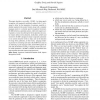2047 search results - page 94 / 410 » The limits of speech recognition |
NAACL
1994
13 years 10 months ago
1994
Improved acoustic modeling can significantly decrease the error rate in large-vocabulary speech recognition. Our approach to the problem is twofold. We first propose a scheme that...
ICASSP
2010
IEEE
13 years 9 months ago
2010
IEEE
Random projection has been suggested as a means of dimensionality reduction, where the original data are projected onto a subspace using a random matrix. It represents a computati...
INTERSPEECH
2010
13 years 3 months ago
2010
This paper describes a new toolkit - SCARF - for doing speech recognition with segmental conditional random fields. It is designed to allow for the integration of numerous, possib...
INTERSPEECH
2010
13 years 3 months ago
2010
In this paper we present a novel algorithm called Suppression of Slowly-varying components and the Falling edge of the power envelope (SSF) to enhance spectral features for robust...
ICASSP
2011
IEEE
13 years 16 days ago
2011
IEEE
In this paper we present a study on phone confusabilities based on phone recognition experiments from facial surface electromyographic (EMG) signals. In our study EMG captures the...

